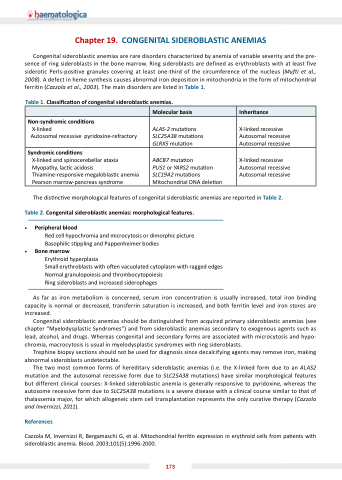Page 186 - Haematologica Atlas of Hematologic Cytology
P. 186
Chapter 19 CONGENITAL SIDEROBLASTIC ANEMIAS
Congenital sideroblastic anemias
are are rare disorders characterized by anemia anemia of variable severity and the pre- sence of ring sideroblasts sideroblasts in in in in the bone marrow Ring sideroblasts sideroblasts are defined as as as as as erythroblasts with at least five siderotic Perls-positive granules covering at least one-third of of the the circumference of of the the nucleus (Mufti et al 2008) A defect in in in heme synthesis causes abnormal iron deposition in in in mitochondria mitochondria in in in the the form of mitochondrial ferritin (Cazzola et al 2003) The main disorders are listed in in in Table 1 Table 1 lassi ca on on of congenital sideroblas c c c anemias
Molecular basis
Inheritance
on on on syndromic condi ons X-linked
Autosomal recessive pyridoxine-refractory
ALAS-2 muta muta ons ons SLC25A38 muta muta muta ons ons GLRX5 muta muta on X-linked
recessive recessive Autosomal Autosomal recessive recessive recessive Autosomal Autosomal recessive recessive Syndromic condi ons X-linked
and spinocerebellar ataxia Myopathy lac c c c c acidosis Thiamine-responsive megaloblas c c c c c anemia Pearson marrow-pancreas syndrome ABCB7 muta muta on PUS1 or YARS2 muta muta muta on on on SLC19A2 muta muta ons Mitochondrial DNA dele on on on X-linked
recessive recessive Autosomal Autosomal recessive recessive recessive Autosomal Autosomal recessive recessive The dis nc ve morphological features of congenital sideroblas c c c c anemias
are reported in Table 2 Table 2 ongenital sideroblas c c anemias
morphological features Peripheral blood
Red cell hypochromia and microcytosis or or dimorphic picture
Basophilic s s s ppling and Pappenheimer bodies
one marrow Erythroid hyperplasia
Small erythroblasts with with o o o o en vacuolated cytoplasm with with ragged edges Normal granulopoiesis and thrombocytopoiesis
Ring sideroblasts and increased siderophages
As far as as iron iron iron metabolism is is is concerned serum iron iron iron concentration is is is usually increased total iron iron iron binding capacity is is normal or or or decreased transferrin saturation is is increased and and both ferritin level and and iron stores are increased Congenital sideroblastic sideroblastic anemias
anemias
should be distinguished from acquired primary sideroblastic sideroblastic anemias
anemias
(see chapter “Myelodysplastic Syndromes”) and from sideroblastic anemias
secondary to exogenous agents such as as as as lead alcohol and and and drugs Whereas congenital and and and secondary forms are associated with microcytosis and and and hypo- chromia macrocytosis is is usual in in myelodysplastic syndromes with ring sideroblasts Trephine biopsy sections should not be used for diagnosis since decalcifying agents may remove iron making abnormal sideroblasts undetectable The two most common forms of hereditary sideroblastic anemias
(i e e e e e e e e e the X-linked
form form due to an an ALAS2 mutation mutation and the autosomal recessive form due to to SLC25A38 mutations) have similar morphological features but different clinical courses: X-linked
sideroblastic anemia is generally responsive to pyridoxine whereas the autosome recessive form due to to to SLC25A38 mutations is is a a a a a a a a severe disease with a a a a a a a a clinical course similar to to to that of thalassemia major for which allogeneic stem cell transplantation represents the the only curative therapy (Cazzola and Invernizzi 2011) References
Cazzola M M Invernizzi R Bergamaschi G et al al Mitochondrial ferri n n n n n n n n expression in erythroid cells from pa ents with sideroblas c c c anemia Blood 2003 101(5):1996-2000 173


